A Deep Dive into Vygotsky's Theories of Child Development and Learning
VerifiedAdded on 2022/08/21
|6
|1154
|11
Essay
AI Summary
This essay delves into the core tenets of Lev Vygotsky's theories on child development and learning. It examines key concepts such as private speech, the zone of proximal development, and the crucial role of culture and environment in shaping a child's cognitive growth. The student's work provides examples and personal experiences to illustrate Vygotsky's ideas, drawing connections between theory and practical application. The essay also discusses the influence of Vygotsky's framework on early childhood education, particularly the Flight Framework, emphasizing the importance of intercultural competence and family involvement. Through analysis and personal reflection, the essay demonstrates a comprehensive understanding of Vygotsky's contributions to the field of developmental psychology and their relevance in contemporary educational practices.
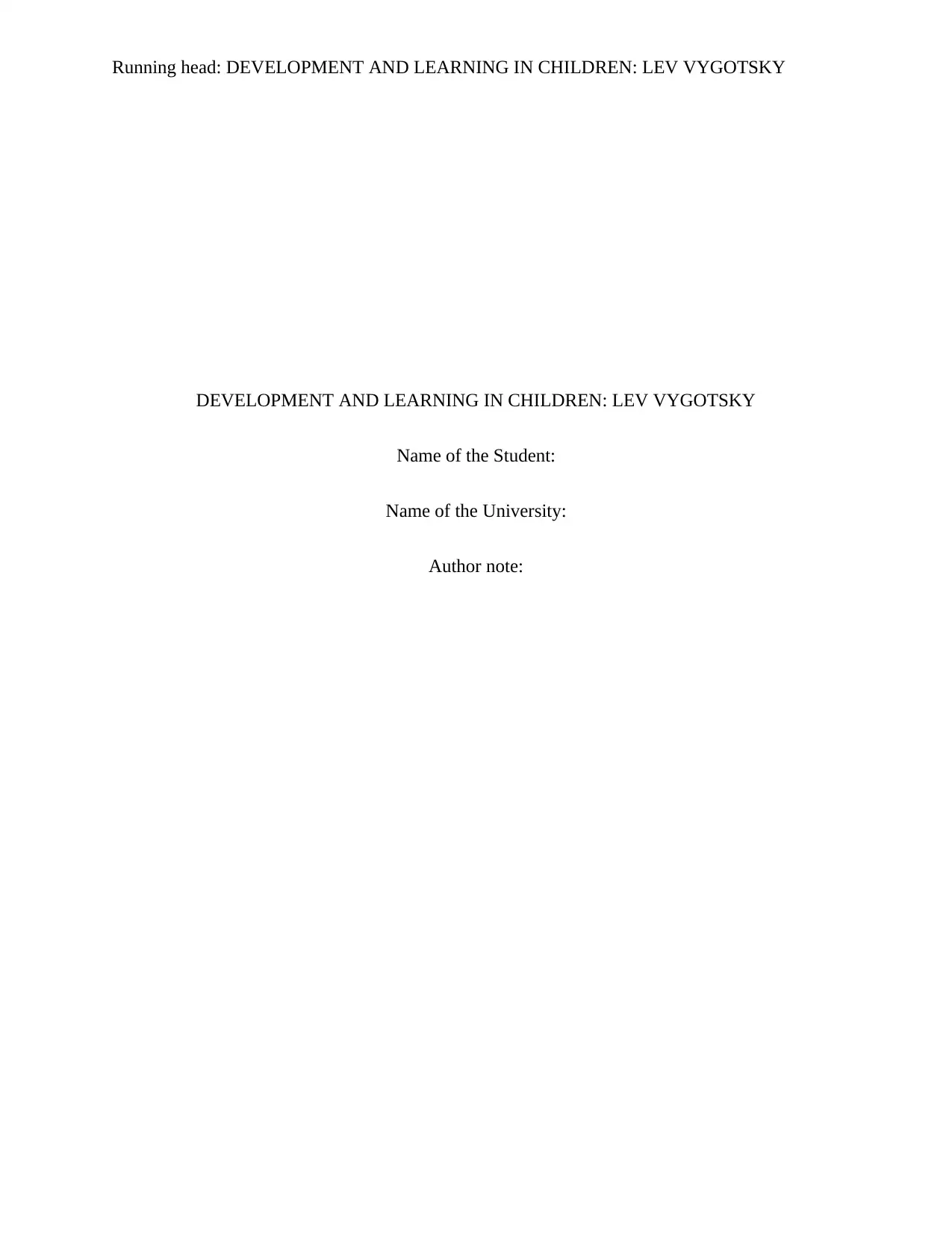
Running head: DEVELOPMENT AND LEARNING IN CHILDREN: LEV VYGOTSKY
DEVELOPMENT AND LEARNING IN CHILDREN: LEV VYGOTSKY
Name of the Student:
Name of the University:
Author note:
DEVELOPMENT AND LEARNING IN CHILDREN: LEV VYGOTSKY
Name of the Student:
Name of the University:
Author note:
Paraphrase This Document
Need a fresh take? Get an instant paraphrase of this document with our AI Paraphraser
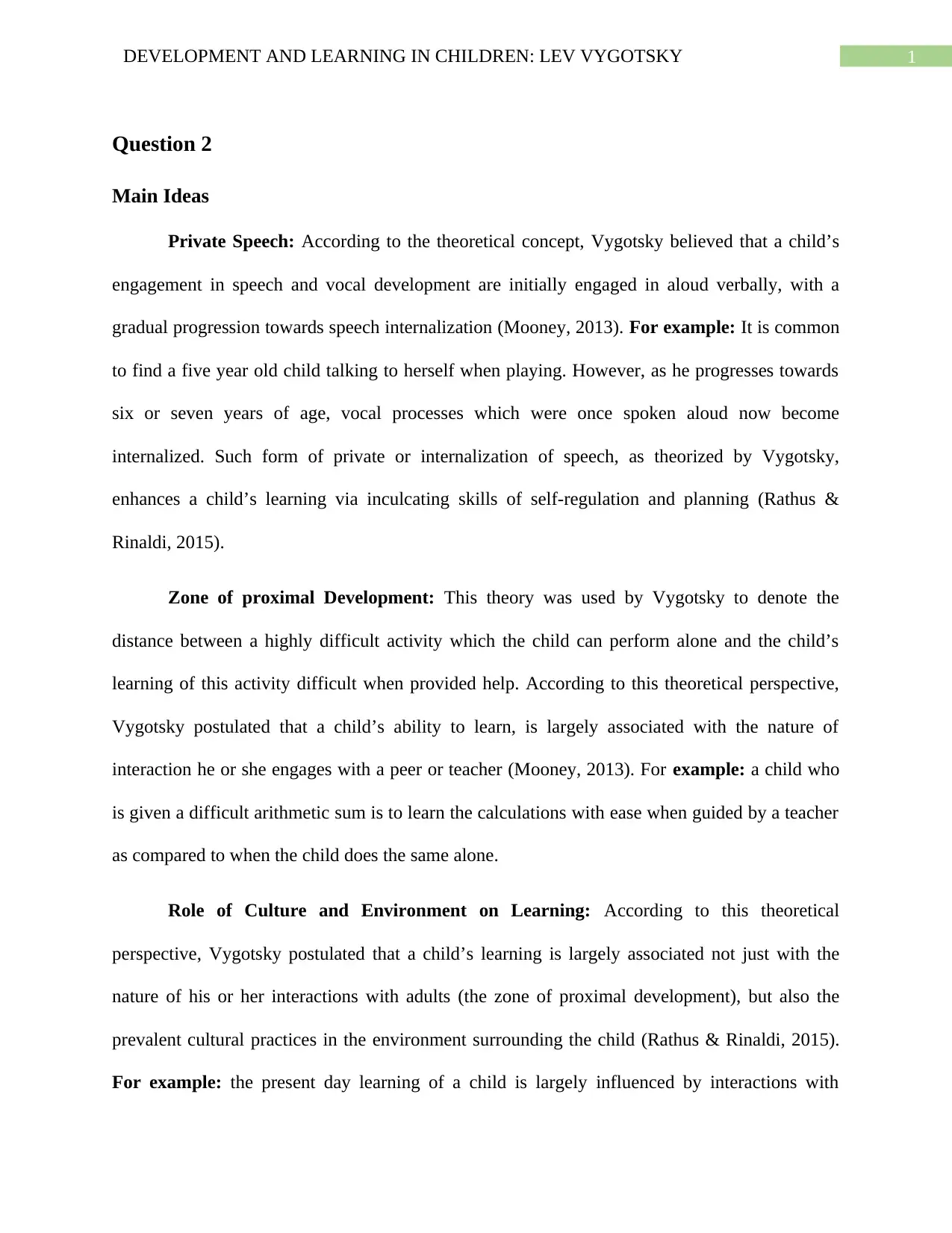
1DEVELOPMENT AND LEARNING IN CHILDREN: LEV VYGOTSKY
Question 2
Main Ideas
Private Speech: According to the theoretical concept, Vygotsky believed that a child’s
engagement in speech and vocal development are initially engaged in aloud verbally, with a
gradual progression towards speech internalization (Mooney, 2013). For example: It is common
to find a five year old child talking to herself when playing. However, as he progresses towards
six or seven years of age, vocal processes which were once spoken aloud now become
internalized. Such form of private or internalization of speech, as theorized by Vygotsky,
enhances a child’s learning via inculcating skills of self-regulation and planning (Rathus &
Rinaldi, 2015).
Zone of proximal Development: This theory was used by Vygotsky to denote the
distance between a highly difficult activity which the child can perform alone and the child’s
learning of this activity difficult when provided help. According to this theoretical perspective,
Vygotsky postulated that a child’s ability to learn, is largely associated with the nature of
interaction he or she engages with a peer or teacher (Mooney, 2013). For example: a child who
is given a difficult arithmetic sum is to learn the calculations with ease when guided by a teacher
as compared to when the child does the same alone.
Role of Culture and Environment on Learning: According to this theoretical
perspective, Vygotsky postulated that a child’s learning is largely associated not just with the
nature of his or her interactions with adults (the zone of proximal development), but also the
prevalent cultural practices in the environment surrounding the child (Rathus & Rinaldi, 2015).
For example: the present day learning of a child is largely influenced by interactions with
Question 2
Main Ideas
Private Speech: According to the theoretical concept, Vygotsky believed that a child’s
engagement in speech and vocal development are initially engaged in aloud verbally, with a
gradual progression towards speech internalization (Mooney, 2013). For example: It is common
to find a five year old child talking to herself when playing. However, as he progresses towards
six or seven years of age, vocal processes which were once spoken aloud now become
internalized. Such form of private or internalization of speech, as theorized by Vygotsky,
enhances a child’s learning via inculcating skills of self-regulation and planning (Rathus &
Rinaldi, 2015).
Zone of proximal Development: This theory was used by Vygotsky to denote the
distance between a highly difficult activity which the child can perform alone and the child’s
learning of this activity difficult when provided help. According to this theoretical perspective,
Vygotsky postulated that a child’s ability to learn, is largely associated with the nature of
interaction he or she engages with a peer or teacher (Mooney, 2013). For example: a child who
is given a difficult arithmetic sum is to learn the calculations with ease when guided by a teacher
as compared to when the child does the same alone.
Role of Culture and Environment on Learning: According to this theoretical
perspective, Vygotsky postulated that a child’s learning is largely associated not just with the
nature of his or her interactions with adults (the zone of proximal development), but also the
prevalent cultural practices in the environment surrounding the child (Rathus & Rinaldi, 2015).
For example: the present day learning of a child is largely influenced by interactions with
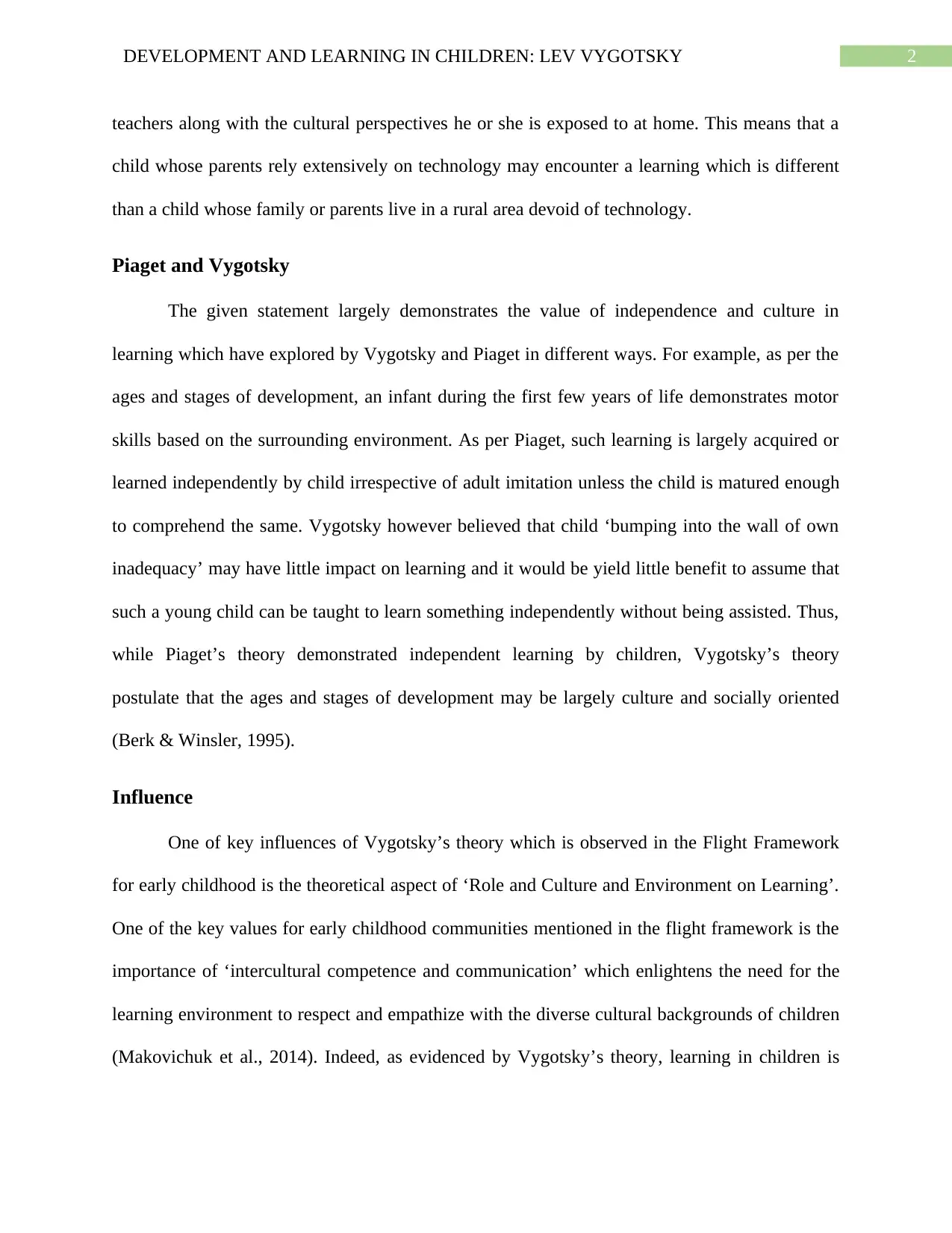
2DEVELOPMENT AND LEARNING IN CHILDREN: LEV VYGOTSKY
teachers along with the cultural perspectives he or she is exposed to at home. This means that a
child whose parents rely extensively on technology may encounter a learning which is different
than a child whose family or parents live in a rural area devoid of technology.
Piaget and Vygotsky
The given statement largely demonstrates the value of independence and culture in
learning which have explored by Vygotsky and Piaget in different ways. For example, as per the
ages and stages of development, an infant during the first few years of life demonstrates motor
skills based on the surrounding environment. As per Piaget, such learning is largely acquired or
learned independently by child irrespective of adult imitation unless the child is matured enough
to comprehend the same. Vygotsky however believed that child ‘bumping into the wall of own
inadequacy’ may have little impact on learning and it would be yield little benefit to assume that
such a young child can be taught to learn something independently without being assisted. Thus,
while Piaget’s theory demonstrated independent learning by children, Vygotsky’s theory
postulate that the ages and stages of development may be largely culture and socially oriented
(Berk & Winsler, 1995).
Influence
One of key influences of Vygotsky’s theory which is observed in the Flight Framework
for early childhood is the theoretical aspect of ‘Role and Culture and Environment on Learning’.
One of the key values for early childhood communities mentioned in the flight framework is the
importance of ‘intercultural competence and communication’ which enlightens the need for the
learning environment to respect and empathize with the diverse cultural backgrounds of children
(Makovichuk et al., 2014). Indeed, as evidenced by Vygotsky’s theory, learning in children is
teachers along with the cultural perspectives he or she is exposed to at home. This means that a
child whose parents rely extensively on technology may encounter a learning which is different
than a child whose family or parents live in a rural area devoid of technology.
Piaget and Vygotsky
The given statement largely demonstrates the value of independence and culture in
learning which have explored by Vygotsky and Piaget in different ways. For example, as per the
ages and stages of development, an infant during the first few years of life demonstrates motor
skills based on the surrounding environment. As per Piaget, such learning is largely acquired or
learned independently by child irrespective of adult imitation unless the child is matured enough
to comprehend the same. Vygotsky however believed that child ‘bumping into the wall of own
inadequacy’ may have little impact on learning and it would be yield little benefit to assume that
such a young child can be taught to learn something independently without being assisted. Thus,
while Piaget’s theory demonstrated independent learning by children, Vygotsky’s theory
postulate that the ages and stages of development may be largely culture and socially oriented
(Berk & Winsler, 1995).
Influence
One of key influences of Vygotsky’s theory which is observed in the Flight Framework
for early childhood is the theoretical aspect of ‘Role and Culture and Environment on Learning’.
One of the key values for early childhood communities mentioned in the flight framework is the
importance of ‘intercultural competence and communication’ which enlightens the need for the
learning environment to respect and empathize with the diverse cultural backgrounds of children
(Makovichuk et al., 2014). Indeed, as evidenced by Vygotsky’s theory, learning in children is
⊘ This is a preview!⊘
Do you want full access?
Subscribe today to unlock all pages.

Trusted by 1+ million students worldwide
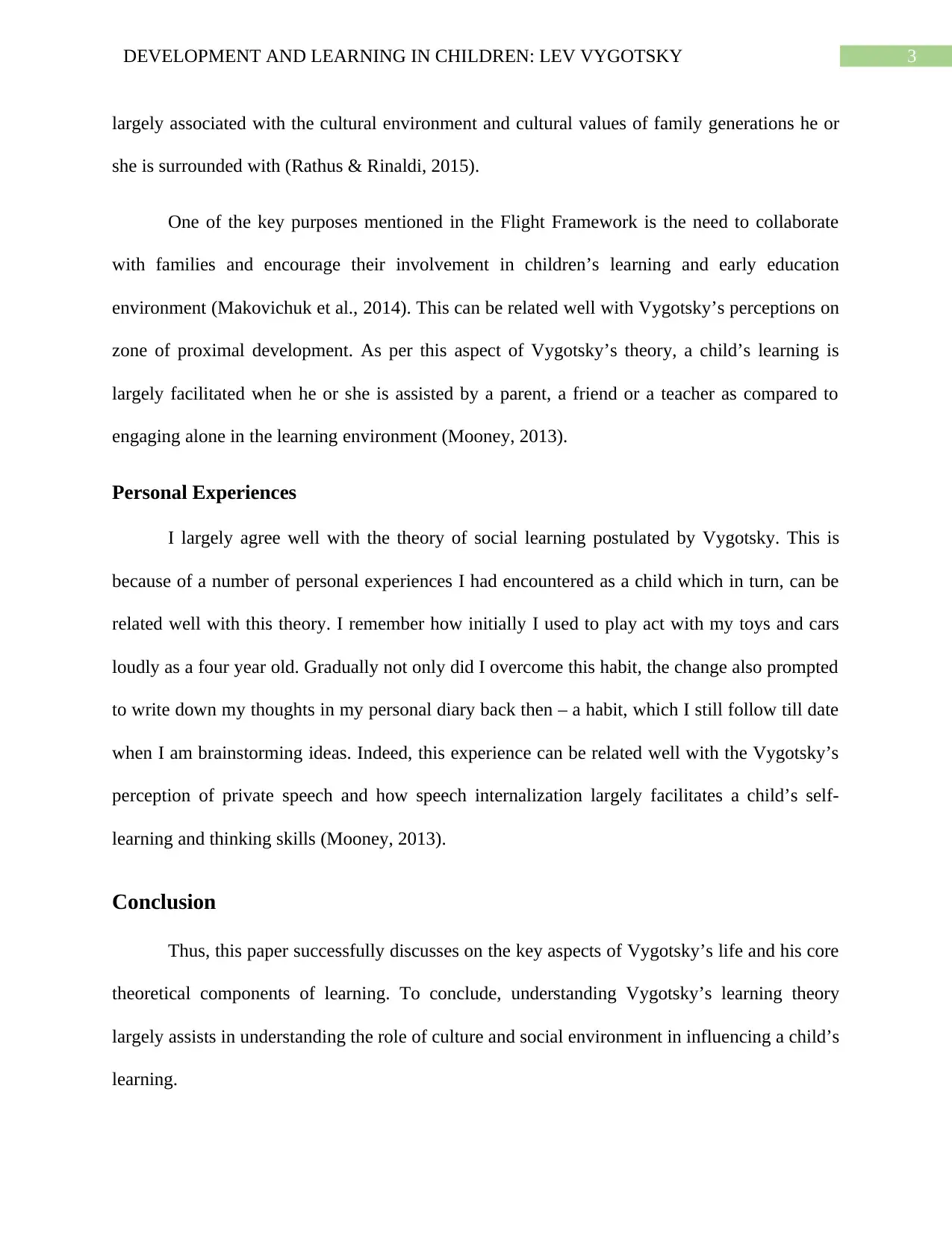
3DEVELOPMENT AND LEARNING IN CHILDREN: LEV VYGOTSKY
largely associated with the cultural environment and cultural values of family generations he or
she is surrounded with (Rathus & Rinaldi, 2015).
One of the key purposes mentioned in the Flight Framework is the need to collaborate
with families and encourage their involvement in children’s learning and early education
environment (Makovichuk et al., 2014). This can be related well with Vygotsky’s perceptions on
zone of proximal development. As per this aspect of Vygotsky’s theory, a child’s learning is
largely facilitated when he or she is assisted by a parent, a friend or a teacher as compared to
engaging alone in the learning environment (Mooney, 2013).
Personal Experiences
I largely agree well with the theory of social learning postulated by Vygotsky. This is
because of a number of personal experiences I had encountered as a child which in turn, can be
related well with this theory. I remember how initially I used to play act with my toys and cars
loudly as a four year old. Gradually not only did I overcome this habit, the change also prompted
to write down my thoughts in my personal diary back then – a habit, which I still follow till date
when I am brainstorming ideas. Indeed, this experience can be related well with the Vygotsky’s
perception of private speech and how speech internalization largely facilitates a child’s self-
learning and thinking skills (Mooney, 2013).
Conclusion
Thus, this paper successfully discusses on the key aspects of Vygotsky’s life and his core
theoretical components of learning. To conclude, understanding Vygotsky’s learning theory
largely assists in understanding the role of culture and social environment in influencing a child’s
learning.
largely associated with the cultural environment and cultural values of family generations he or
she is surrounded with (Rathus & Rinaldi, 2015).
One of the key purposes mentioned in the Flight Framework is the need to collaborate
with families and encourage their involvement in children’s learning and early education
environment (Makovichuk et al., 2014). This can be related well with Vygotsky’s perceptions on
zone of proximal development. As per this aspect of Vygotsky’s theory, a child’s learning is
largely facilitated when he or she is assisted by a parent, a friend or a teacher as compared to
engaging alone in the learning environment (Mooney, 2013).
Personal Experiences
I largely agree well with the theory of social learning postulated by Vygotsky. This is
because of a number of personal experiences I had encountered as a child which in turn, can be
related well with this theory. I remember how initially I used to play act with my toys and cars
loudly as a four year old. Gradually not only did I overcome this habit, the change also prompted
to write down my thoughts in my personal diary back then – a habit, which I still follow till date
when I am brainstorming ideas. Indeed, this experience can be related well with the Vygotsky’s
perception of private speech and how speech internalization largely facilitates a child’s self-
learning and thinking skills (Mooney, 2013).
Conclusion
Thus, this paper successfully discusses on the key aspects of Vygotsky’s life and his core
theoretical components of learning. To conclude, understanding Vygotsky’s learning theory
largely assists in understanding the role of culture and social environment in influencing a child’s
learning.
Paraphrase This Document
Need a fresh take? Get an instant paraphrase of this document with our AI Paraphraser
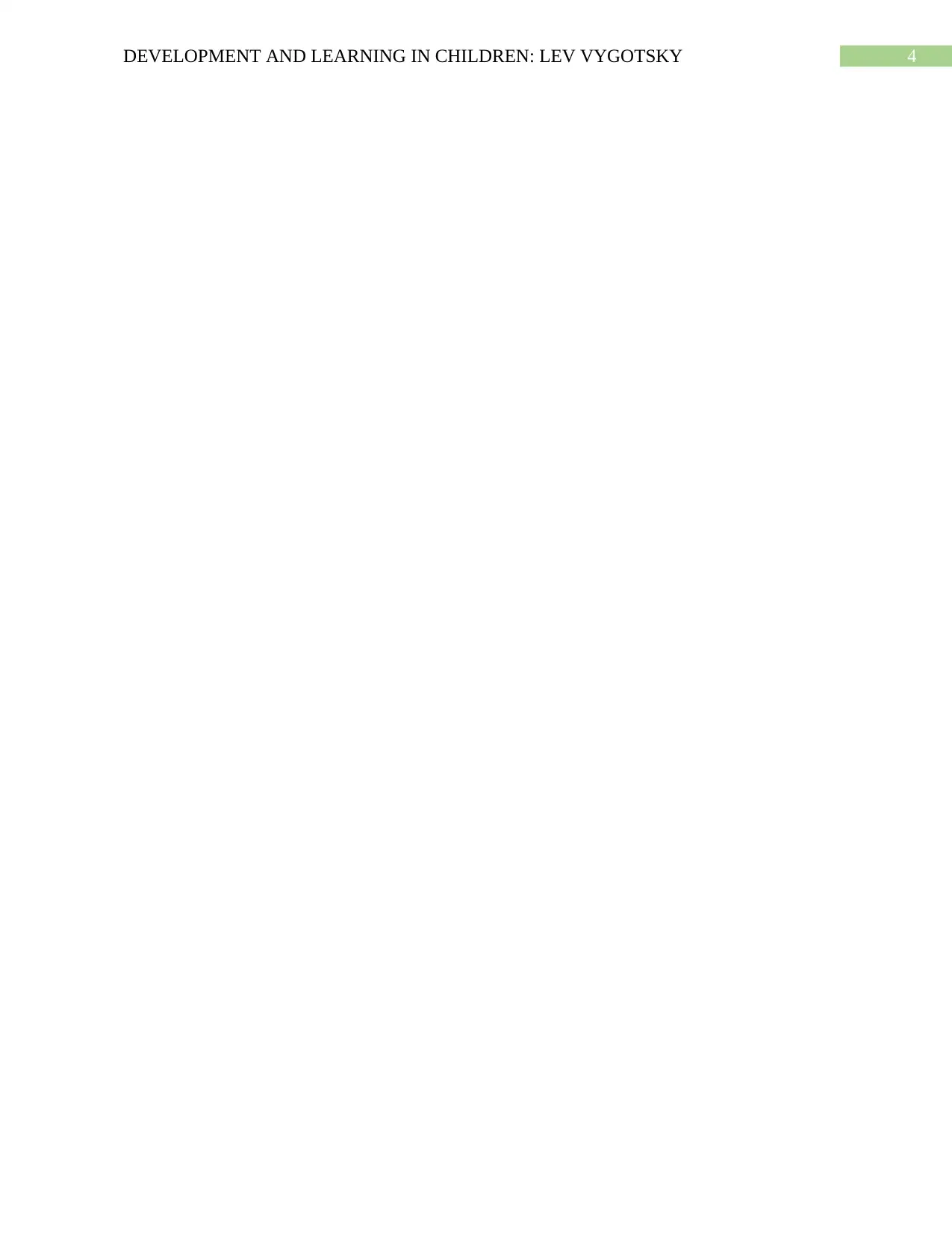
4DEVELOPMENT AND LEARNING IN CHILDREN: LEV VYGOTSKY
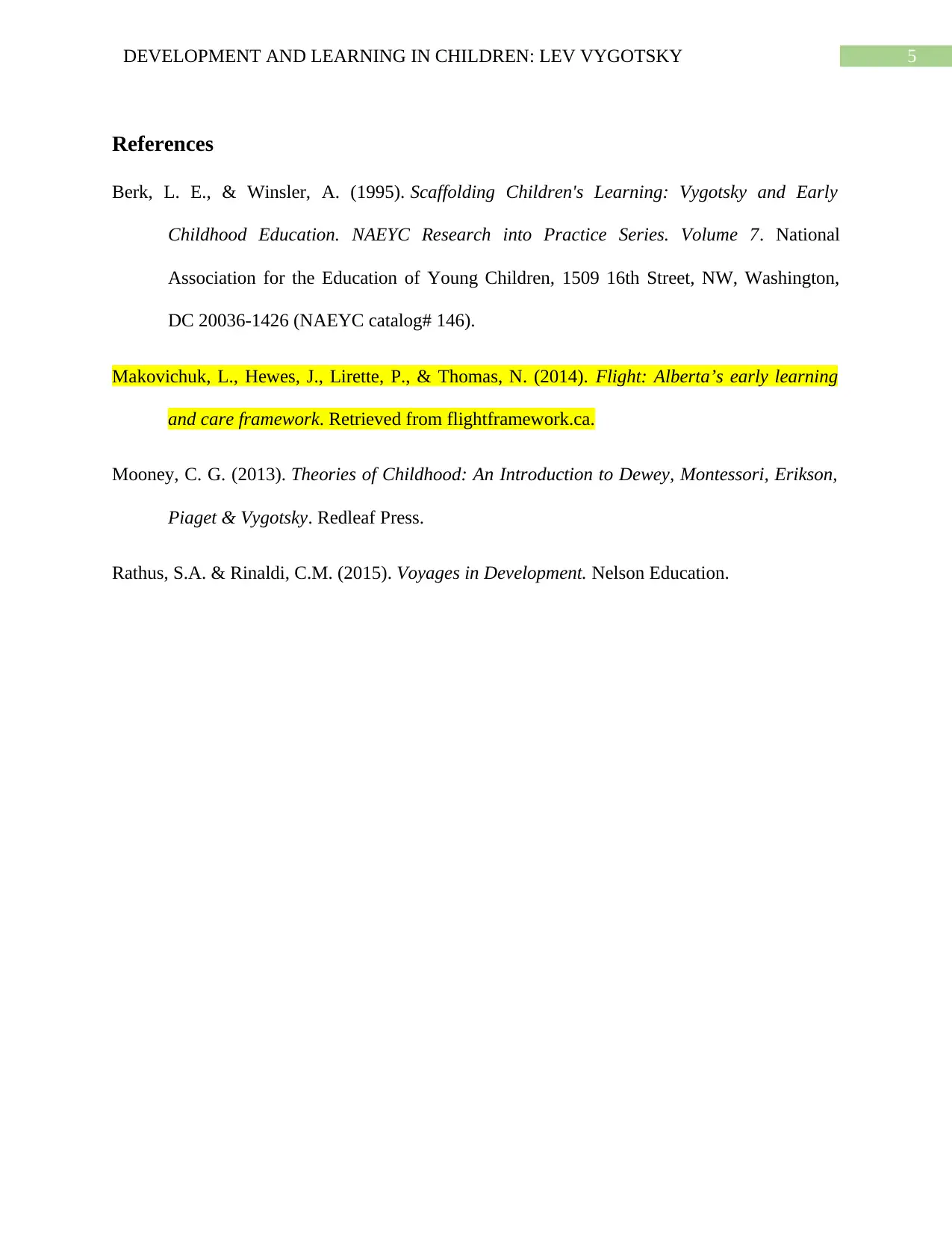
5DEVELOPMENT AND LEARNING IN CHILDREN: LEV VYGOTSKY
References
Berk, L. E., & Winsler, A. (1995). Scaffolding Children's Learning: Vygotsky and Early
Childhood Education. NAEYC Research into Practice Series. Volume 7. National
Association for the Education of Young Children, 1509 16th Street, NW, Washington,
DC 20036-1426 (NAEYC catalog# 146).
Makovichuk, L., Hewes, J., Lirette, P., & Thomas, N. (2014). Flight: Alberta’s early learning
and care framework. Retrieved from flightframework.ca.
Mooney, C. G. (2013). Theories of Childhood: An Introduction to Dewey, Montessori, Erikson,
Piaget & Vygotsky. Redleaf Press.
Rathus, S.A. & Rinaldi, C.M. (2015). Voyages in Development. Nelson Education.
References
Berk, L. E., & Winsler, A. (1995). Scaffolding Children's Learning: Vygotsky and Early
Childhood Education. NAEYC Research into Practice Series. Volume 7. National
Association for the Education of Young Children, 1509 16th Street, NW, Washington,
DC 20036-1426 (NAEYC catalog# 146).
Makovichuk, L., Hewes, J., Lirette, P., & Thomas, N. (2014). Flight: Alberta’s early learning
and care framework. Retrieved from flightframework.ca.
Mooney, C. G. (2013). Theories of Childhood: An Introduction to Dewey, Montessori, Erikson,
Piaget & Vygotsky. Redleaf Press.
Rathus, S.A. & Rinaldi, C.M. (2015). Voyages in Development. Nelson Education.
⊘ This is a preview!⊘
Do you want full access?
Subscribe today to unlock all pages.

Trusted by 1+ million students worldwide
1 out of 6
Related Documents
Your All-in-One AI-Powered Toolkit for Academic Success.
+13062052269
info@desklib.com
Available 24*7 on WhatsApp / Email
![[object Object]](/_next/static/media/star-bottom.7253800d.svg)
Unlock your academic potential
Copyright © 2020–2025 A2Z Services. All Rights Reserved. Developed and managed by ZUCOL.





